The First Week
What you need and tips to help you acclimate your greyhound to your home.

Things you will need:
1. Read at least one book about greyhound adoption. There are many very good books available that provide useful information about greyhound adoption. Our recommendation for the "best" book to read is Retired Racing Greyhounds for Dummies by Lee Livingood. It is an old book and some of the information is out of date but it is still the best book we have found. We keep this book and Childproofing Your Dog by Brian Kilcommons in stock.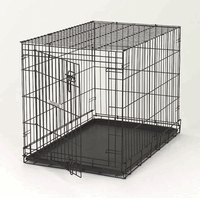
2. A crate. We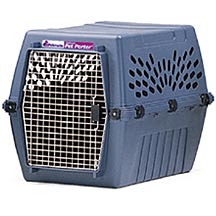 highly recommend that adopters buy a crate before bringing home their new greyhound. Crates are available on-line as well as at many pet stores. We recommend either the plastic "airline" crates or wire crates. Plastic crates typically divide in half for storage or moving whereas wire crates can often collapse down into a flat (if somewhat bulky) object for storage or moving. Either type of crate will work for a greyhound as long as they are the right size. Very small female greyhounds can fit into a crate that is 42 inches long but most females and males need the larger 48 inch long crates. If you have a larger, taller male look for an extra tall crate 35" or 36" inches high. These will still be 48" long, just taller. This is usually only necessary if you are adopting a male that is over 80 lbs. If you decide to get a wire crate, you may want to look for the crates that have doors on the narrow end (as shown in the picture to the right) as well as a door on the wide side of the crate. This allows for much greater flexibility in placing the crate in your house. Folding metal crates are a little more expensive than the pin style metal crates, but are much easier to move and put together, so we think they are well worth the cost. If the dog you are getting has houdini tendencies, the plastic airline style crates are the best bet, which is why those are required for shipping dogs.
highly recommend that adopters buy a crate before bringing home their new greyhound. Crates are available on-line as well as at many pet stores. We recommend either the plastic "airline" crates or wire crates. Plastic crates typically divide in half for storage or moving whereas wire crates can often collapse down into a flat (if somewhat bulky) object for storage or moving. Either type of crate will work for a greyhound as long as they are the right size. Very small female greyhounds can fit into a crate that is 42 inches long but most females and males need the larger 48 inch long crates. If you have a larger, taller male look for an extra tall crate 35" or 36" inches high. These will still be 48" long, just taller. This is usually only necessary if you are adopting a male that is over 80 lbs. If you decide to get a wire crate, you may want to look for the crates that have doors on the narrow end (as shown in the picture to the right) as well as a door on the wide side of the crate. This allows for much greater flexibility in placing the crate in your house. Folding metal crates are a little more expensive than the pin style metal crates, but are much easier to move and put together, so we think they are well worth the cost. If the dog you are getting has houdini tendencies, the plastic airline style crates are the best bet, which is why those are required for shipping dogs.
 3. Food, water and dishes. Most of our members feed their greyhounds a high quality dry dog food. Typically this is dog food that can be purchased in pet stores or tractor supply companies. When looking for a specific type of dog food, we recommend finding a food that does not have corn. wheat or soy beans listed in the ingredients and has meat as at least two of the first 5 ingredients. Many of our adopters like Kirklands dry and canned food from Costco. It is the most economical food that we recommend. If you look at the ingredients it is comparable to the $50+ high end foods, but is around $30 for a 40 lb bag. An even better option is Nature's Select Multi Protein Dry Dog food, and that is what we provide to many of our foster homes. It is delivered to your home and is not available in pet stores. For that first week we recommend adding 2 heaping tablespoons of plain yogurt (unsweetened) that contains active cultures to the food. The active cultures in yogurt helps settle the dog's stomach and can help prevent unwanted gastric side-effects, especially if you feed your new greyhound a different type of food than he was getting in his foster home. After the first week, you can experiment with other tasty morsels to add to your dog's food. Also, remember to always have fresh water available for your greyhound. Finally, for dishes, we recommend the stainless steel dishes. These are easier to keep clean than plastic dishes. Greyhounds eat soft food at the track so we usually add water to their food to make it soupy although we don't wait for the food to get soft. This helps prevent choking on the dry food at first. A raised feeder is NOT necessary for greyhounds and does NOT help prevent bloat as people once thought. Most greyhounds prefer to eat in their crates because that is what they are used to doing at the track.
3. Food, water and dishes. Most of our members feed their greyhounds a high quality dry dog food. Typically this is dog food that can be purchased in pet stores or tractor supply companies. When looking for a specific type of dog food, we recommend finding a food that does not have corn. wheat or soy beans listed in the ingredients and has meat as at least two of the first 5 ingredients. Many of our adopters like Kirklands dry and canned food from Costco. It is the most economical food that we recommend. If you look at the ingredients it is comparable to the $50+ high end foods, but is around $30 for a 40 lb bag. An even better option is Nature's Select Multi Protein Dry Dog food, and that is what we provide to many of our foster homes. It is delivered to your home and is not available in pet stores. For that first week we recommend adding 2 heaping tablespoons of plain yogurt (unsweetened) that contains active cultures to the food. The active cultures in yogurt helps settle the dog's stomach and can help prevent unwanted gastric side-effects, especially if you feed your new greyhound a different type of food than he was getting in his foster home. After the first week, you can experiment with other tasty morsels to add to your dog's food. Also, remember to always have fresh water available for your greyhound. Finally, for dishes, we recommend the stainless steel dishes. These are easier to keep clean than plastic dishes. Greyhounds eat soft food at the track so we usually add water to their food to make it soupy although we don't wait for the food to get soft. This helps prevent choking on the dry food at first. A raised feeder is NOT necessary for greyhounds and does NOT help prevent bloat as people once thought. Most greyhounds prefer to eat in their crates because that is what they are used to doing at the track.
4. Dog bed or a stack of old blankets. Your new greyhound doesn't have and shouldn't have fat as padding. He really needs a padded place to lie down and be comfortable. If you let him, he will be happy to be on your bed or couch, but a dog bed will also work just fine! You can buy dog beds large enough and fluffy enough for our greys at places like Target, Sams Club, Costco or on the web. If you get a dog bed or use a stack of old blankets and place it in a corner where your new greyhound can observe the activity of the family around him, you will probably be pleasantly surprised at how quickly he starts using the dog bed. Don't forget to get some blankets to put in his crate too. Bony greyhounds need lots of padding there too. We use a couple of twin sized comforters from Goodwill in crates. They fit in our washer better than the crate pads sold with the crates and only cost a few dollars.
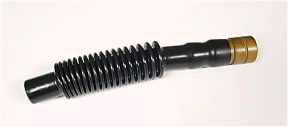 5. Squawker. If you haven't owned or been around greyhounds much, you may not know what a squawker or a predator call is. A squawker is a wild-animal call that can be used to call your greyhound to you. When you squeeze it, it makes a sound that is generally very attractive to greyhounds. This is something they were trained with when they were learning to race and they associate it with getting to chase the lure - something they really enjoy. The main use for squawkers is in emergency situations. We don't like to think of our greyhounds getting away from us, but it can happen. In fact, the most likely time for it to happen is in the first few months of greyhound-ownership when you, as a new owner, are still learning what it is like to
5. Squawker. If you haven't owned or been around greyhounds much, you may not know what a squawker or a predator call is. A squawker is a wild-animal call that can be used to call your greyhound to you. When you squeeze it, it makes a sound that is generally very attractive to greyhounds. This is something they were trained with when they were learning to race and they associate it with getting to chase the lure - something they really enjoy. The main use for squawkers is in emergency situations. We don't like to think of our greyhounds getting away from us, but it can happen. In fact, the most likely time for it to happen is in the first few months of greyhound-ownership when you, as a new owner, are still learning what it is like to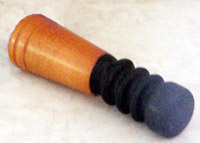 own and handle a greyhound. Greyhounds are so fast...it is amazing how rapidly they can get away. But, a squawker can be used to call your dog back! Once in running or chase mode they often will not respond to their name, but will respond to the squawker. Our recommendation is to have at least 2 squawkers; one for your house and one for in your car, especially if you take your dog for rides. Sometimes you can find squawkers at outdoor sport supply locations. You can find them on-line in our Greyhound Crossroads Online Store.
own and handle a greyhound. Greyhounds are so fast...it is amazing how rapidly they can get away. But, a squawker can be used to call your dog back! Once in running or chase mode they often will not respond to their name, but will respond to the squawker. Our recommendation is to have at least 2 squawkers; one for your house and one for in your car, especially if you take your dog for rides. Sometimes you can find squawkers at outdoor sport supply locations. You can find them on-line in our Greyhound Crossroads Online Store.
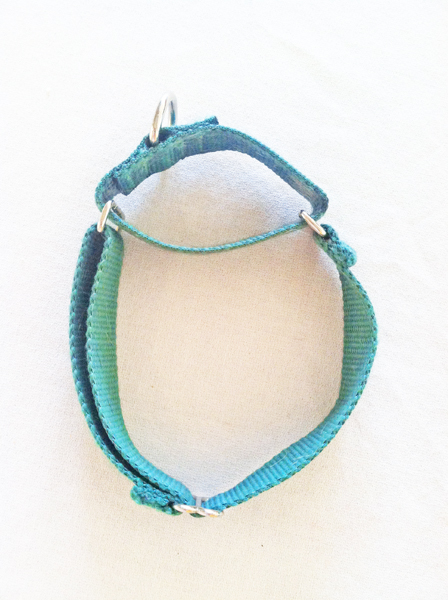 6. Martingale collar, tag collar and a leash. Greyhounds should wear martingale collars (a modified choke collar) when they are on a leash. As shown in the picture, martingales have an extra loop in the collar that, when fitted properly, allow the collar to be tightened so that it won't slip over the head of the greyhound. Greyhounds heads are as narrow as their neck and regular dog collars will slide off if the greyhound pulls backwards. We require that our new owners have a martingale collar or purchase one from us when they pick up their greyhound. At that time, we demonstrate to the owner how to adjust the collar so that it fits their dog properly. Three fingers should fit between the two metal rings at the top. We recommend having one standard buckle tag collar to keep on the dog all the time and a separate martingale for use with a leash for walks. You can remove the martingale collar in the house since the loops can get caught on things like crates and cabinet pulls and leave on the tag collar. You can use any standard leash (nylon or leather) with the martingale collar. DO NOT use retractable leashes with greyhounds. A greyhound that hits the end of a long retractable leash at full speed can dislocate your shoulder, break the leash or break its neck.
6. Martingale collar, tag collar and a leash. Greyhounds should wear martingale collars (a modified choke collar) when they are on a leash. As shown in the picture, martingales have an extra loop in the collar that, when fitted properly, allow the collar to be tightened so that it won't slip over the head of the greyhound. Greyhounds heads are as narrow as their neck and regular dog collars will slide off if the greyhound pulls backwards. We require that our new owners have a martingale collar or purchase one from us when they pick up their greyhound. At that time, we demonstrate to the owner how to adjust the collar so that it fits their dog properly. Three fingers should fit between the two metal rings at the top. We recommend having one standard buckle tag collar to keep on the dog all the time and a separate martingale for use with a leash for walks. You can remove the martingale collar in the house since the loops can get caught on things like crates and cabinet pulls and leave on the tag collar. You can use any standard leash (nylon or leather) with the martingale collar. DO NOT use retractable leashes with greyhounds. A greyhound that hits the end of a long retractable leash at full speed can dislocate your shoulder, break the leash or break its neck.
7. Fenced-in yard. At Greyhound Crossroads we do not require that our adopters have fenced-in yards. However, for those members that do, it is important to carefully go over the yard to make sure that it is dog safe. Greyhounds aren't typically diggers or jumpers, so usually you don't have to be too concerned about the dog jumping over the fence or trying to dig out of the fence. But, do make sure that there aren't any good sized gaps in the fence that the dog could push through and that the gates close and latch properly. Also, be sure to use some type of clasp to make sure that the latch on the gate doesn't come open easily or allow the dog to accidentally push it open.
 8. Busy toy (Kong toy). A kong toy can be used to help fill your dog's time when you leave them alone. Many of us actually use them to encourage our dogs to get in the crate when we have to leave. You can fill the toy with peanut butter or cream cheese and let your dog spend time licking the treat out of the toy. Try freezing the toy with peanut butter or cream cheese in it to make it last just a little longer.
8. Busy toy (Kong toy). A kong toy can be used to help fill your dog's time when you leave them alone. Many of us actually use them to encourage our dogs to get in the crate when we have to leave. You can fill the toy with peanut butter or cream cheese and let your dog spend time licking the treat out of the toy. Try freezing the toy with peanut butter or cream cheese in it to make it last just a little longer.
9. Enzyme cleaner meant for pet messes. No dog comes "potty trained". No matter how perfectly potty trained a dog may be in his foster home he will NOT understand that the same rules apply in your house. Dogs don't think like humans and have to be trained in each new place they go in to. Your new greyhound is likely to have at least a few accidents while you are teaching him the rules in your home. Dogs occasionally get sick and throw up and have diarrhea so you will need the cleaner eventually.
When you bring a new greyhound into your home be aware of these anxiety triggers and give him time to adapt:
Novelty - everything is new to him - new household items, new people, new animals, and first time in a house.
Invasion of personal space - disruption when resting, hugging, kissing, forcibly restraining. We know you want to love your new dog but give him space to avoid stressing him out. Think about how you would feel if complete strangers were doing the same to you.
Changes in housing - moving to a new foster home, then a new adoptive home.
Changes in household members - new foster family, adoptive family and possibly kids and new pets in the household to adjust to.
Separation from human family and dog family members - losing his race trainer and his littermates, losing foster family, and losing you when you leave for work.
Changes in routine - new feeding schedule, new potty break schedule, new house rules and often more time out of the crate than he is comfortable with.
Physical stress - recent spay or neuter surgery, vet stay, worming, and shots.
Lack of outlets for normal breed behaviors - after training and racing for months, if not years, he is suddenly retired and no longer allowed to do what he was bred for for thousands of years and what he loves more than anything - chasing a lure. No matter your personal opinion of racing, your greyhound loved to chase a lure more than he will ever love laying on your couch and more than he will love you. He didn't care why he ran, if he won, if he won money or not, he just loved chasing. There is no jockey to encourage a greyhound to run or run faster. They will choose to chase a lure over food, drink, sleep or even the opposite sex. Greyhounds will chase to the point of heat exhaustion and even death, if a human does not stop them. This is the reason greyhounds can not be trusted off leash outside a fenced area. No matter how much your greyhound grows to love you, he will choose the chase over you, and will not come back when you call. Anyone who has owned a greyhound can confirm that greyhounds even dream about chasing the lure. Many owners eventually let their retirees chase a lure at greyhound play groups, lure coursing meets or for fun amateur race meets in the area.
Things to do at home:
1. Keep the first few days as simple and stress free as possible for your new greyhound. Only introduce him to your immediate family members. Avoid inviting in the neighborhood to show off your new greyhound. You will have time for that later. In the beginning, give your new dog a chance to adjust to his new home and new family. As tempting as it is to lavish your new friend with attention, it is actually better if you can almost ignore your new dog for the first few days. Give him plenty of down time and don't encourage excitement. Dogs respond best to calm, laid back owners. Don't allow family members to force unwanted attention on a new dog and keep attention to a minimum. Supervision is important, but too much love and affection can be overwhelming and unwanted. You want your greyhound to feel the need to seek YOU out to get affection rather than feeling like you are a bothersome stalker. Here is a fantastic link that explains why you want to keep the first few days calm Trigger Stacking - Too much too soon.
2. Use the crate!! Use the crate if you have to leave the dog at home or if the dog is acting overwhelmed by too many people, too many new things, etc. In the crate, the dog is safe from household distractions and from situations that may be overwhelming to a new dog in a new home. If you are concerned about the dog in the crate, try giving them a kong toy filled with cream cheese or peanut butter, a stuffed toy, or even an old t-shirt that you have worn and not washed. The scent of their new owner can help dogs bond to you and help calm them when you are away. Remember greyhounds are used to living in a crate but aren't used to being in your home. Most feel safer and more comfortable in a familiar crate than loose in a strange house. A crate is also essential for potty training properly. Many dogs will only lay down and really relax in a crate at first so make sure you give them plenty of crate time to rest and sleep.
3. Don't be afraid to use bribes to get your greyhound into the crate. The new crate at your house is not your greyhound's crate yet. Even a greyhound that prefers to be in crates, may not want to go in a strange new crate at first. Many of our members use string cheese, peanut butter smeared in a kong toy, etc to get our dogs to go in the crate. If the greyhound still won't go in, it won't traumatize them if you push them in. At the track there was no option about going in a crate and no such thing as a greyhound that "wouldn't crate". Greyhounds are very accustomed to living in a crate. Your greyhound should earn his freedom from the crate with good behavior. Allowing too much freedom too early causes potty training issues and can actually put your dog's life in danger if it gets ahold of something dangerous while you are gone. Allowing your greyhound to refuse to go in the crate, teaches him that being stubborn or throwing fits keeps him from having to do things he doesn't want to do.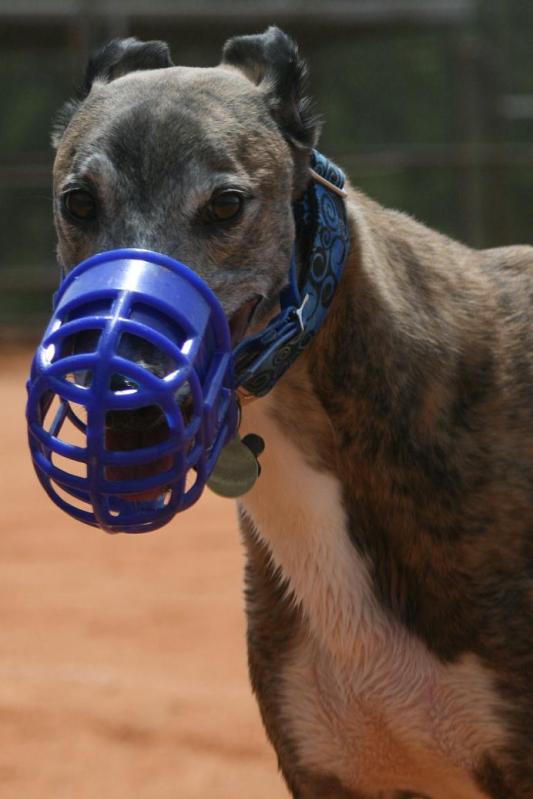
4. Use your dog's muzzle when you feel unsure about how the dog may react around other members of the family and pets. This is especially necessary if you have other dogs, small dogs, cats, or even small children. We aren't saying to keep your dog muzzled forever, just use the muzzle judiciously in the first few weeks while your dog is adapting to his new home and meeting new cats and small dogs that could be mistaken for bunnies. Remember that your greyhound's job has been to chase small furry things up until now. Even the ones that seem small animal safe, need time to get adjusted to seeing fast movements around them without chasing. You will receive a muzzle with your dog. Greyhounds always had their muzzles put on before leaving their kennel to go outside at the track. Most look on a muzzle fondly because it is associated with going outside. Don't feel bad about using the muzzle that comes with your dog. It is your insurance policy that keeps your pets, other people's pets, and even a greyhound that gets into things, safer. Hold onto that muzzle because it can come in handy to prevent licking and chewing at hot spots or stitches. Greyhounds prefer the muzzle to wearing those horrible Elizabethan collars also known as "the Cone of Shame" that vets use to prevent chewing out stitches.
5. Keep a collar and ID on the dog at all times. As mentioned above, you may choose to use a house collar with ID on your dog all the time and then have a separate martingale collar that is just put on for leash walks. You will be given one of our Greyhound Crossroads ID tags when you adopt your dog. Please have your dog wear it and get one with your own contact information on it as soon as possible. Most people have their dogs wear both so there are two numbers to call if someone finds your dog. Many owners also choose to have their new greyhounds microchipped.
6. Always use a martingale collar when you are outside a fenced-in area. Greyhounds heads are often smaller than their necks, so they can slip out of standard buckle collars very easily. Martingale collars are modified choke collars and are required for greyhounds. Remember, a loose greyhound is often a lost or dead greyhound. Lets not let that happen to your new family member!
7. If you have children under 10 years of age in your home, work with your greyhound from the beginning to help the greyhound understand that these small humans are "above" him or her in the pack structure. There are a few simple things to help this:
- Whenever the dog and child passes through a door, hold the dog back by the collar so that the child goes through first. This teaches polite, respectful behavior in general.
- Have the child, at unexpected times, call the dog to him or her, pet the dog and at the same time give the dog a yummy treat.
- Don't allow the dog to "own" space. Dog beds, human beds and couches belong to the humans, but the humans allow the dog to use them. That privilege can be lost if there is any growling or fussing at any family members.
- Have the child feed the dog. An adult can prepare the food and then an adult should hold the dog by the collar. Then the child takes the food and puts the food down on the floor or in the crate. Then the child should step away from the food and "release" the dog by saying "OK" or "Get it" or "Yours." Only then does the adult release the dog so the dog can get the food. This teaches the dog that good things come from the child and that the child "owns" the food and is sharing it. It also teaches the dog to wait for permission to take food. Never let a child approach any dog that is eating or chewing on a treat!!
- Getting a new dog is exciting, but don't let the child follow the dog around and give it unwanted affection. Hugging, kissing and staring into the dog's eyes can all be misinterpreted by the dog as aggression on the part of the child, so should never be allowed with a new dog. Teach the child to give the dog its' space. If the dog walks away from a child it should never be followed. You want a dog that avoids kids, when it has had enough, rather than growling or snapping. Make sure the child knows to let the dog walk away. Teach your children never to touch a dog that is laying down or sleeping. That old saying "Let a sleeping dog lie" is great advice. Ignoring that saying is the root of most conflict between children and dogs.
- Supervise! Supervise! Supervise! We can't emphasize this enough. Most trouble between kids and dogs happens when children are unsupervised. The dog never gets to tell his side of the story.
If you have questions on how to help young children and greyhounds adapt to each other, please let us know. We have more information on our Kids and Greyhounds page.
8. Plan to feed your new dog twice a day AND ADD WATER TO HIS FOOD AT FIRST! The best thing to do is ask the foster parents how much they were feeding your greyhound. That will give you a good idea of how much food your dog is eating. Greyhounds eat raw meat mixed with kibble at the track that is mushy. Most have NEVER eaten plain dry dog food and in most cases will choke on it at first. Adding water to their food immediately before feeding will make the dog lap between bites and slow down his eating and will prevent most choking. It isn't necessary to soften the food first. Gradually put less and less water on the food until the dog learns to eat it dry. Never free feed and never feed over 3 cups of dog food per meal! Over feeding WILL give your greyhound diarrhea and 3 cups of food per meal seems to be the line you don't want to cross. Most greyhounds need much less than this to maintain a good weight anyway.
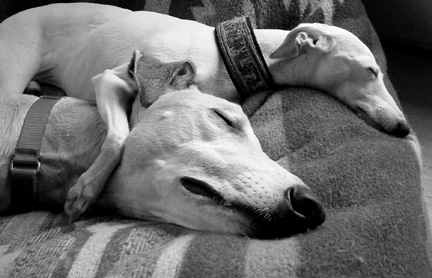 Feel free to add good tasting things to the food for your dog. We recommend adding 2 heaping tablespoons of plain yogurt containing active cultures to the food for at least the first several days to a week. The active cultures in the yogurt helps to settle the stomach. You may also want to consider adding Omega 3 Fatty Acids (fish oil) to the food as a supplement. Omega 3s often help your dog develop a full, soft, shiny coat. In addition, you could consider adding a joint supplement to the food especially if you have adopted one of our older dogs. As in humans, Glucosamine, Chondroitin and MSM supplements help with the joints.
Feel free to add good tasting things to the food for your dog. We recommend adding 2 heaping tablespoons of plain yogurt containing active cultures to the food for at least the first several days to a week. The active cultures in the yogurt helps to settle the stomach. You may also want to consider adding Omega 3 Fatty Acids (fish oil) to the food as a supplement. Omega 3s often help your dog develop a full, soft, shiny coat. In addition, you could consider adding a joint supplement to the food especially if you have adopted one of our older dogs. As in humans, Glucosamine, Chondroitin and MSM supplements help with the joints.
As tempting as it is to fatten up a skinny greyhound, remember that they are supposed to have a couple of ribs showing and/or the tips of both hipbones. A fat greyhound is more unhealthy and prone to injuries than one that is at racing weight and on the thin side. Do NOT over feed your greyhound! For more information go to our proper weight page
9. Give your dog frequent chances to go outside to go potty especially during that first week or so. Be sure to watch your new greyhound closely in the house to prevent accidents. We recommend leashing the dog to you for the first few days, anytime it is out of the crate. This way, if the dog starts to go, you can correct and get it to the proper spot outside. Every accident is a learning experience. The dog never has the chance to begin eliminating in the house if you supervise properly. Graduate to having the dog in the room with you by closing doors or using baby gates so you can still watch it.
You want the dog to develop the habit of going outside in the proper spot from the start. A bad habit takes much longer break, than the few days to a couple weeks of supervision it takes to teach your dog proper potty manners in the first place. Also, as with a puppy, if your greyhound has been sleeping for a while (and they do that a lot), take her immediately outside to relieve herself WHEN she wakes up. At the track when they come out of their crate they go straight out to potty. Your greyhound will expect that, even if they have only been in the crate for a short time. An important thing to remember is that our retired racers do not know how to "ask" to go outside when they have to relieve themselves. They always went out as a group on a set schedule at the track. It is our job to learn their signals - usually sniffing, walking quickly or circling. Most greyhounds learn not to eliminate in the house with surprising ease, especially if you are careful with them from the beginning. If you have a male that is a marker you may want to make a belly band.
10. Consider giving your dog raw bones as a supplement to their diet. Check our Facebook page for information. Several of us give raw soup bones or other large uncooked bones to our dogs just as a supplement to their largely dry dog food diet. The uncooked bones provides extra calcium and do an amazing job of keeping the dogs' teeth clean! If you have adopted one of our older dogs or if your dog had multiple tooth extractions as part of their dental, talk to us before giving the raw bones to make sure that your dog can chew them.
11. Bathe your greyhound or not- If your greyhound just had a topical flea or tick treatment applied in the last two days, do not bathe them. Greyhounds do not need baths often, but if they still have a kennel or vet office smell, you may want to bathe your new hound. Important to note that many greyhounds will relax so much that they slide down in the tub or shower and almost appear to faint. This is NORMAL and DOES NOT mean your greyhound has a medical problem. It helps to use cooler water, but some will even do it in cold water. They will get back up within a minute or so after the bath.
Things to do soon:
1. Get an identity tag to put on the collar of your dog, include dog's name, your name, address, and cell phone number. These are very handy just in case your new greyhound gets away from you somehow. You can get very nice engraved ID tags on several web sites and at some pet stores.
2. Get flea medication and heart worm medication. We recommend using Comfortis for flea control. It is a pill that works for 1 to 3 months per dose. Topical flea treatments like Frontline and Advantage just don't seem to work to control fleas for us anymore, but are also safe for greyhounds to use. Trifexis is a heartworm preventative that also controls fleas that is very effective. Most other heartworm preventatives your vet prescribes are fine for greyhounds. You can get these products at most veterinarian offices. You can sometimes get them at a cheaper rate from an animal shelter, a "traveling vet" or online. It is important to give heartworm preventative every month! Flea and tick meds can be given just as needed and aren't usually necessary in the winter months.
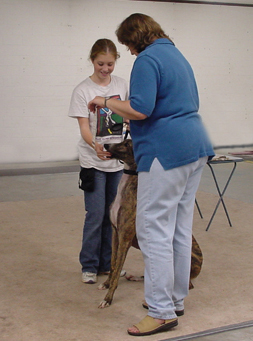 3. Take a basic dog obedience class. This is a very good idea no matter how well behaved your greyhound is. Basic obedience will help you bond with your new greyhound. Plus it helps your greyhound learn to trust you and look to you for instructions. Once you have taught your new greyhound some basic commands, such as sit, down, and stay, you will often find it much easier to control your new family member. We highly recommend Jane Fink at Anderson Dog Works in Anderson SC, the trainers at Speedy Paws in Greenville and the trainers Jae-Mar-S in Augusta.
3. Take a basic dog obedience class. This is a very good idea no matter how well behaved your greyhound is. Basic obedience will help you bond with your new greyhound. Plus it helps your greyhound learn to trust you and look to you for instructions. Once you have taught your new greyhound some basic commands, such as sit, down, and stay, you will often find it much easier to control your new family member. We highly recommend Jane Fink at Anderson Dog Works in Anderson SC, the trainers at Speedy Paws in Greenville and the trainers Jae-Mar-S in Augusta.
4. Find a vet that is familiar with greyhounds. This is VERY VERY important! Greyhounds have some fairly specialized medical issues that you need to be sure that your vet is familiar with. For example, greyhounds tend to be very sensitive to anesthetics and are frequently misdiagnosed with kidney failure and enlarged heart by vets that aren't familiar with them. They can have mixed reactions to steroids (often given for allergies) and even painkillers like Tramadol. There is a book on medical issues in greyhounds called Care of the Racing and Retired Greyhound that is a fantastic resource that you may want to purchase for your vet. An excellent website on greyhound health issues is greythealth.com. The vets that handle most of our greyhounds are Dr Paula Watkins at Emerald City Vet in Greenwood, SC and Dr Jennifer Ng at Northeast Animal Clinic in Columbia, SC. They will be glad to give you a second opinion. We have vets on our forum and on Facebook that will also be glad to talk to you about medical issues you may be faced with.
5. Find a suitable kennel or reliable pet sitter for those times that you need to be away from home for one or more days. To see a list of recommended kennels and persons within Greyhound Crossroads who are interested in trading pet sitting duties, please visit our Greyhound Crossroads Facebook page. Willow Haven Canine Retreat in Piedmont SC is one of the kennels we recommend that is run by greyhound people.
6. Get your greyhound officially registered in your name thru the National Greyhound Association. The NGA offers us the chance to get an adoption certificate through their website. Just follow the pet certificate link on the left side. You first get the form from the NGA, then send it to the person who owned your dog as a racer (the NGA provides the address and name of the owner) with a stamped-self-addressed envelope. Your dog's racing owner has to sign it and return the form to you. Then you send the form back to the NGA with a $30 check and they will mail you (surprisingly quickly) a very nice official pet certificate for your new family member. The certificate contains information about your dog's breeding history and identification information such as the ear tattoos and color markings. If your greyhound were to get lost and the NGA is called to identify the dog by its tattoos they could correctly tell the caller where the dog belonged rather than sending them to its previous racing owner. Be sure to keep this information updated if you move!
7. Become more involved in Greyhound Crossroads! We don't do meet and greets or hold a lot of events like we used to when we had more dogs to place. We still have some tasks we need help with though. We need volunteers to help with occasional fund raisers. We still need people to pick up and drop off dogs at the vet and foster dogs. If you are interested or think of any other way you would like to help, please talk to your adoption rep or our director Kim Owens.
8. Visit our Favorite Links for more information about greyhounds and greyhound adoption. There are many links to health information, historical information, and other good stuff about greyhounds, and, of course, links to things you can buy for both you and your greyhound! Visit often and stay informed.
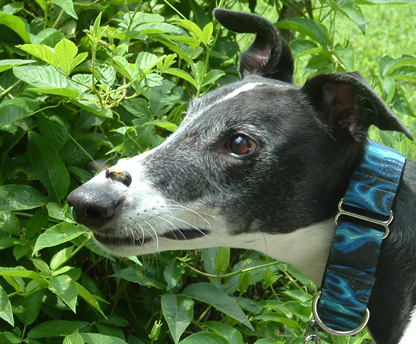
Previous page: Choosing a Greyhound
Next page: Adoption Application